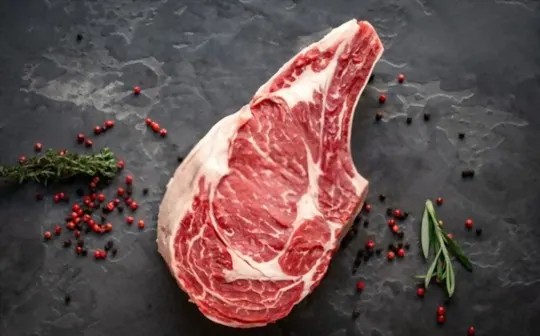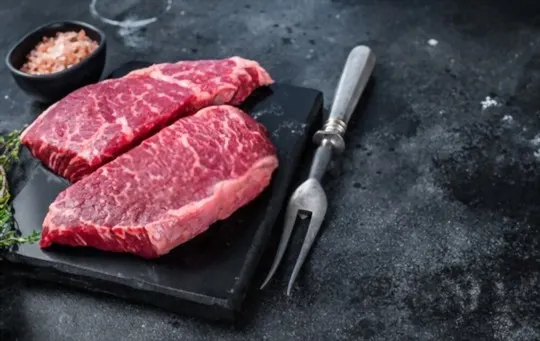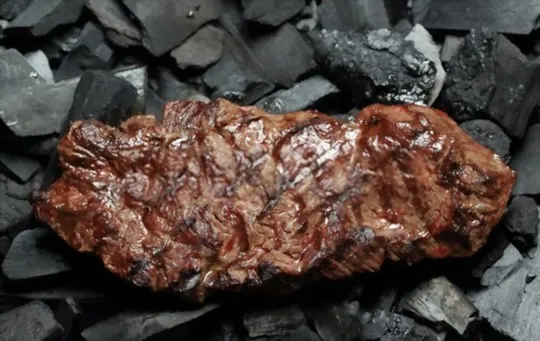In the land of steaks, two giants stand tall: Denver steak and Ribeye. We’re here to slice through the confusion.
First off, both pack a punch in flavor. Ever tried chewing a cloud made of meat? That’s Ribeye for you, while Denver is the Chuck Norris of steak – tough yet surprisingly tender.
We’ve had our battles with the grill. Picture this: a sunny day, the grill sizzling, and us with two different cuts of beef. Ah, the drama!
Denver is leaner, Ribeye is juicier. Remember, folks, it’s all about what tickles your fancy.

What is Denver Steak?

Denver Steak is a relatively new cut of beef that has gained popularity in recent years.
It is a tender and juicy cut that comes from the area around the chuck, specifically the fourth rib.
Unlike other cuts like Ribeye, Denver Steak comes with some unique features that contribute to its distinctive taste.
- Denver Steak contains fine white marbling throughout the steak, making it tender and flavorful.
- It is leaner than Ribeye but still packs a rich flavor profile.
- This cut also has superior texture due to its inherent marbling and muscle structure.
- In comparison to Ribeye, Denver Steak can be cooked similarly but will have a slightly chewier texture when served medium-rare or higher. .
- This cut typically weighs between 8 to 12 ounces per piece.
While not as widely recognized as other cuts like T-bone or New York strip steak, Denver Steak offers great versatility in cooking because of its leanness.
You can grill, roast, fry or even sous-vide this steak for an exceptional dining experience.
Overall, We can say that Denver Steak offers a unique flavor profile and tenderness compared to other popular steak types.
Its lower price point makes it an attractive option for budget-conscious consumers who still want high-quality beef.
What is Ribeye?

Ribeye is a juicy and flavorful cut of beef that comes from the ribs of a cow.
Known for its high marbling and tenderness, ribeye is perfect for grilling or pan-frying.
The meat contains both the longissimus dorsi muscle and the spinalis muscle, which gives it a rich texture and bold flavor.
When compared to other cuts of beef, ribeye has a higher fat content, making it more suitable for those who prefer a richer taste.
Additionally, because ribeye is cut from the ribs of the cow, it tends to be slightly more expensive than other cuts like sirloin or flank.
One unique feature of ribeye is that it can come bone-in or boneless.
The bone-in variant provides even more flavor and adds an element of visual appeal to dishes.
Overall, ribeye is a beloved cut of beef that is popular in steakhouses and home kitchens alike.
Differences Between Denver Steak and Ribeye

Denver Steak and Ribeye are commonly known beef cuts but what makes them different? The Denver steak is taken from the bottom part of the chuck primal while the Ribeye comes from the upper rib area.
Cut and Location on the Animal
Cut and location on the animal play a significant role in determining the flavor and tenderness of steaks.
Various cuts have different characteristics that impact their taste.
Steaks located in high movement areas such as the rib are more tender due to the presence of fat and connective tissue than those located in low movement regions like the shoulder, which is leaner but tougher.
Denver steak and ribeye steak come from different parts of the animal, with slight variations in their texture, taste, and cooking methods.
Ribeye, taken from the middle section of the ribcage, has marbling throughout its flesh, making it well-suited for high heat cooking techniques such as grilling or broiling.
Denver steak comes from the underblade muscle at the shoulder’s end, making it less tender than ribeye but equally flavorful when cooked correctly.
While both are prime cuts of beef with exceptional taste profiles, individual preference determines which one stands out.
Factors like personal cooking skills, budget for meat purchase, flavor profile preference can all influence one’s choice between a Denver steak or rib-eye steak.
Marbling and Fat Content
The marbling and fat content of a Denver steak and ribeye greatly affect their taste and tenderness.
The more marbled the meat is, which means the intramuscular fat is distributed evenly throughout the meat, the more flavorful and tender it will be.
A ribeye typically has a higher fat content and more marbling than a Denver steak, which makes it juicier and richer in taste.
However, while a ribeye may have more fat content, it does not necessarily mean it is always better.
The high-fat content can make it too rich for some people’s tastes.
On the other hand, a Denver steak has less fat but still retains its tenderness due to its muscle structure.
It also has a slightly beefier flavor than a ribeye.
It’s important to note that both cuts of meat are delicious in their own ways and ultimately depend on personal preference.
If you’re someone who enjoys a little more fat in your steak for added flavor, go for the ribeye.
But if you want a leaner option that still delivers on tenderness and flavor, try out the Denver steak instead.
Flavor and Texture
The difference in mouth-watering flavor and succulent texture of Denver Steak and Ribeye largely depends on the level of marbling, cut location, cooking method, and seasoning used.
Both cuts offer a rich, beefy taste with varying degrees of tenderness.
Denver Steak is leaner and has a distinct beef flavor with more teriyaki notes, while Ribeye has more fat marbling throughout the cut, resulting in a buttery texture and earthy sweetness.
To enhance the experience further, choosing the appropriate marinade or dry rubbing method can truly bring out the nuances in each steak’s unique flavor profile.
Cooking Methods and Best Uses
When it comes to cooking beef, understanding the best methods and uses of different cuts can make all the difference in your meal’s taste.
Denver steak and ribeye are two popular cuts with distinct differences in tenderness, flavor, and price.
Denver steak is a relatively new cut compared to its counterparts like ribeye.
It comes from the chuck section of the cow, making it more economical than ribeye.
It has a rich, beefy taste with a slightly chewy texture that works well on the grill or broiled under high heat.
The best way to cook Denver steak is medium-rare to rare because prolonged cooking can result in toughness.
On the other hand, ribeye is one of the most expensive cuts due to its high marbling content that adds flavor and tenderness.
It comes from the primal cut section of the cow, making it more tender than Denver steak.
Grilling or pan-frying are ideal cooking methods for ribeye as they allow for even browning while retaining its natural flavors.
What sets these two apart is their fat content; while ribeye has visible marbling within the meat, Denver steak has little visible fat but still delivers excellent flavors with proper cooking techniques.
In summary, choosing between Denver steak and ribeye depends on your preference for tenderness, marbling, flavor profile and budget.
Understanding how different cooking methods affect each cut can transform an average meal into an unforgettable culinary experience.
Similarities Between Denver Steak and Ribeye

While Denver steak and Ribeye are both considered prime cuts of beef, they share not only similarities but also significant differences.
These two cuts have comparable marbling and texture, making them ideal for grilling or pan-searing.
The steaks come from the same section of the cow’s rib area.
They are well-known for their rich flavor and tenderness that can be enhanced by proper preparation techniques.
Denver steak and Ribeye also differ in terms of their shape, size, and amount of fat content.
Denver steaks are typically smaller than Ribeyes and have a unique triangular shape.
They contain less fat marbling than Ribeyes but retain an excellent balance of meat to fat than other steaks from this section.
Additionally, Denver steaks tend to be slightly chewier when compared to Ribeye.
It is noteworthy that although both these cuts are delicious on their own, cooking methods do differ depending on personal preferences of the maker.
While Ribeye usually boasts more fat content (hence more calories) that sears nicely and melts while cooking, Denver steak may require a bit more attention given its leaner nature.
Overall, both steaks make a great option for beef enthusiasts when prepared just right.
Their notable differences combined with similarities offer an array of choices to cater to different taste or diet requirements without losing out on quality or flavor.
How to Prepare and Season Denver Steak and Ribeye?
Denver Steak and Ribeye are two of the most popular types of steaks that people often enjoy.
If you want to prepare and season these delicious cuts of meat, there are several things you need to keep in mind.
Here’s a guide on how to make the best out of your Denver steak and Ribeye:
- Choose high-quality meat: The quality of meat you choose can make or break your dish. Opt for fresh, well-marbled cuts with some nice fat content.
- Preheat your oven/grill: Before cooking, ensure that your grill/oven is preheated to at least 400 degrees F.
- Season generously: Seasoning is crucial when it comes to enhancing the flavor of meat. Marinate both steaks with salt, pepper, and other seasonings of your choice.
- Cook thoroughly: Cook for about 3-5 minutes on each side until it reaches your desired doneness level.
- Let it rest before slicing: After cooking, let the steak rest for about 5 minutes before slicing to allow the juices to redistribute evenly throughout the meat.
It’s worth noting that Denver steak is leaner than Ribeye but also less tender; hence its unique taste.
Also, Ribeye has a higher fat content and marbling which gives it a rich flavor and tenderness suitable for grilling or broiling.
Knowing what type of seasoning works best depending on what cut you choose will make all the difference in enjoying a delectable steak experience.
Conclusion
Comparing Denver steak vs ribeye, both are popular beef cuts that have distinct differences in terms of texture, flavor and price point.
While ribeye is known for its rich marbling and juicy quality, Denver steak boasts a more robust flavor profile due to its meaty and slightly chewy consistency.
Additionally, Denver steak is typically a more affordable option compared to ribeye.
Ultimately, the choice between the two cuts depends on personal taste preferences and budget.

Leave a comment